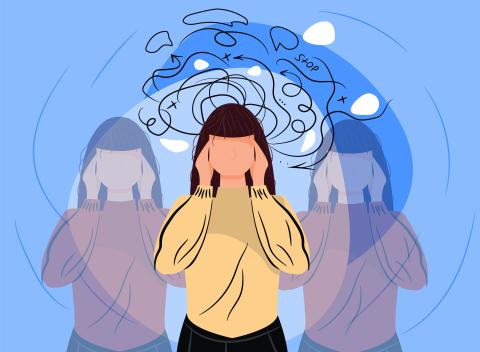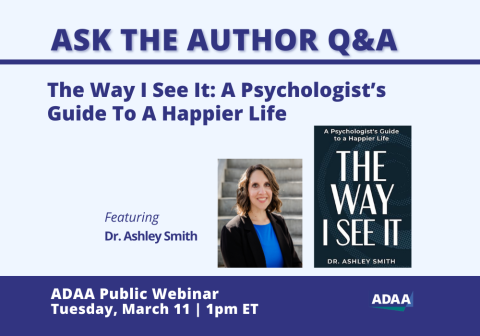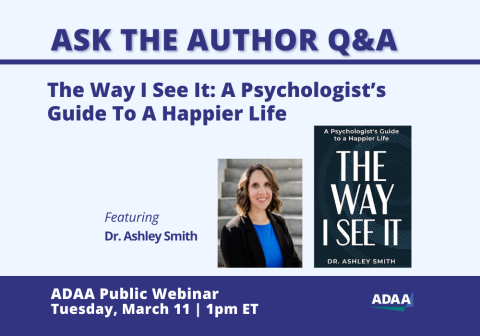Diagnostic and Statistical Manual of Mental Disorders (DSM-5)
For diagnostic criteria and codes, visit the Anxiety Disorders page of the DSM-5;requires subscription and login.
Social Anxiety Disorder
People with social anxiety disorder experience fear in one or more social situations persisting at least six months. They consistently experience anxiety that is out of proportion to the actual threat posed by the feared situation. The individual will either avoid the situation or endure it with high levels of distress. This anxiety significantly interferes with functioning or normal routines in the areas of work or school, social activities, and relationships. Social anxiety relates to the fear of being evaluated by others. Most of us have some level of social anxiety when meeting new people, talking to someone we are attracted to, or performing in front of a group such as making a toast at a wedding. We may feel embarrassment when making social mistakes, like forgetting someone’s name or giving the wrong answer to a question.
What differentiates clinically severe social anxiety disorder from the social anxiety experienced to some degree by most people are the intensity and persistence of the anxiety, shame, and embarrassment and the extent of avoidance of situations and people that trigger anxiety. People with social anxiety are usually aware that their anxiety is out of proportion to the situations, but this awareness does not decrease their level of anxiety or their urge to escape.
People with social anxiety disorder may have panic attacks anticipating or during triggering situations. Unlike those with panic disorder, who often fear that a panic attack will result in dying or going crazy, socially anxious people with panic attacks are afraid of doing something that would embarrass them.
Due to the intense anxiety experienced in relation to social situations, socially anxious people will often use safety behaviors (e.g., rehearsing what they are going to say; asking questions instead of talking about themselves; wear makeup to cover blushing) or avoidance as coping mechanisms. While these tactics may work in the short run to decrease their anxiety, they come at a high cost of interference with functioning in the areas of relationships, school, and work.
Typical situations that trigger intense anxiety and possibly avoidance:
• Starting or maintaining a conversation
• Participating in small groups
• Eating in front of others
• Giving a presentation
• Asking someone out
• Being the center of attention
• Urinating in the presence of others
• Any situation with potential for appearing nervous to others or being observed blushing, sweating or shaking
Children and Teens
The typical age of onset for social anxiety disorder is between the ages of 13 and 18, but it may occur in younger children. Selective mutism, which is a separate diagnostic category in DSM-5, is a form of social anxiety that usually manifests in children between the ages of 3 and 6. Children with selective mutism avoid speaking in situations such as at school, doctors’ visits, or around people other than their family.
Typical situations that trigger intense anxiety and avoidance in children and teens:
• Answering questions in class
• Asking the teacher a question
• Ordering food at restaurants
• Inviting others to get together
• Oral presentations
• Talking on the phone or texting
• Going to birthday parties
• Attending school dances
Treatment Options
| Adults | Children and Teens | |
| First-Line Treatments: Psychotherapy | Cognitive-behavioral therapy (CBT), the clear first-line psychotherapeutic treatment, can be administered in group or individual format. The most effective component of CBT is exposure to feared social situations. On average, individual CBT lasts 15-20 sessions. Techniques included: psychoeducation about the disorder, exposure to feared social situations, cognitive restructuring exercises before and after exposures, modification of core beliefs, and relapse prevention. Exposure exercises may be usefully designed to include an emphasis on focusing attention outward rather than on the self and refraining from the use of subtle avoidance or safety behaviors. |
CBT involves the child and parents: psychoeducation about the disorder and the relationship between anxious thoughts, feelings, and avoidance behavior. Cognitive restructuring involving identifying distortions and developing more realistic thoughts can be helpful. An essential component to the treatment is exposure to feared social situations, done in vivo and/or imaginal. SET-C, a CBT program combining exposure therapy with social skill training, has been shown to be effective for children between ages 6 and 14. Can be delivered individually and in group; usually 12 to 24 sessions. Parents are integral and are taught how to reinforce the child’s approach to situations that trigger anxiety. |
| First-Line Treatments: Pharmacotherapy | SSRIs and SNRIs venlafaxine are the clear first-line pharmacotherapy treatment based on demonstrated efficacy in randomized controlled trials and meta-analyses. Medications in these classes that have been FDA-approved in the U.S. are paroxetine (immediate-release and controlled release), sertraline, fluvoxamine controlled release, and venlafaxine extended release. Other medications in these classes with evidence of efficacy from randomized controlled trials include citalopram, escitalopram, and vilazodone. Fluoxetine has had mixed results in randomized controlled trials. SNRIs should be used with caution in patients at risk for suicide due to greater toxicity in overdose. No individual medication within this class has been consistently shown to be superior to another in this class. SSRIs and SNRIs have not been specifically studied for the performance type of this disorder. | SSRIs** First-line treatment SSRIs, the most favorable treatment options due to their efficacy, safety, and tolerability. Specific SSRIs that have been examined include fluoxetine, sertraline, fluvoxamine, paroxetine, escitalopram, and citalopram. Most of the pharmacological studies (youths ages 7-17) comprised the anxiety triad of symptoms and disorders: the combination of separation anxiety disorder, generalized anxiety disorder, and social anxiety disorder; few data are specific to the pharmacotherapy treatment of social anxiety disorder in children and teens. |
| First-Line Treatments: Combined | Little evidence suggests that combinations of psychotherapy and pharmacotherapy are more efficacious than either modality administered alone. The literature is simply too small, and the conclusions are inconsistent. However, combination with first-line pharmacotherapies may be useful for patients who have shown only partial response to a course of CBT. | Limited evidence from one study: Combined treatment with CBT and sertraline was superior to either treatment alone, and all treatments were superior to placebo. |
| Second-Line Treatments: Psychotherapy | CBT Variants. Some evidence suggests that exposure without cognitive restructuring is as efficacious as exposure with the cognitive component. But much more evidence is in favor of the full CBT approach, and exposure without the cognitive component is recommended only if the patient has difficulty with those activities or the feared situation is narrowly defined and specific. Recent research has demonstrated preliminary efficacy of CBT focused on intolerance of uncertainty in social situations. Although promising, insufficient research prevents this approach from being considered a first line treatment. Transdiagnostic group therapy (in which individuals with social anxiety disorder may be treated alongside individuals with other anxiety or emotional disorders) has shown very positive results in early trials and may be equivalent to diagnosis-specific approaches. CBT administered via the Internet shows great promise. Current data suggest that therapist- or coach-assisted programs may be preferable to fully self-administered programs. A concern about Internet CBT is the screening of patients to make sure that the content is appropriate for the patient and that there are not more pressing clinical concerns that should receive prior attention. Mindfulness and Acceptance-Based Therapies. This category includes acceptance and commitment therapy (ACT), mindfulness-based stress reduction (MBSR), and mindfulness and acceptance-based group therapy (MAGT); all have demonstrated efficacy in waitlist controlled trials. One study found MBSR to be efficacious but inferior to group CBT on measures of social anxiety and treatment response. Other trials have demonstrated similar efficacy of ACT and MAGT to CBT. Although the quality of this research is quite good, the number of trials is modest. Applied Relaxation Training. Progressive muscle relaxation training has not demonstrated efficacy as a treatment. However, applied relaxation, in which the patient learns to practice relaxation skills while engaging in increasingly complex activities and then in feared social situations has demonstrated efficacy in a number of trials. In one trial comparing applied relaxation to CBT, whereas applied relaxation was superior to waitlist, it was not as successful as CBT. Social Skills Training. Very popular for many years based on the idea that social anxiety is based on a deficit in social skills, social skills training has shown little efficacy in controlled trials. The social skills deficit theory has not maintained traction in the research community, but it is clear that it applies well in some individual cases, and it should be considered on that basis. Interpersonal Psychotherapy. Although much of CBT is interpersonally focused and some evidence suggests that this emphasis may be useful, interpersonal psychotherapy (IPT), a well-established treatment for depression that focuses on interpersonal problems (i.e. grief, role disputes, role transitions, and interpersonal deficits) has much less supportive data in the treatment of social anxiety. In one large-scale trial, IPT was superior to the control condition but less efficacious than CBT, both immediately post-treatment and at a one year follow-up. Psychodynamic Psychotherapy. Psychodynamic therapy has only been studied in controlled trials in recent years, and the literature base is not yet adequate to suggest it as a strong alternative; it is offered here only if other psychotherapeutic options have been unsuccessful or unavailable. The particular variety known as supportive expressive psychotherapy (SEP) in one large multisite clinical trial yielded better response than waitlist but lesser response than CBT at post-test. However, two-year follow-up data showed little difference between SEP and CBT. |
N/A |
| Second-Line Treatments: Pharmacotherapy | Another SSRI or SNRI: Patients who do not response to a single trial of an SSRI or SNRI sometimes respond to another medication within this class. Other antidepressants: Mirtazapine has had mixed results in randomized controlled trials. Moclobemide, a reversible inhibitor of monoamine oxidase, has had mixed results in randomized controlled trials; meta-analyses suggest it may not be as efficacious as SSRIs. Phenelzine, a monoamine oxidase inhibitor, has appeared highly efficacious in several randomized controlled trials, but is reserved for treatment refractory patients due to its need for dietary restrictions to minimize risk of hypertensive reactions. Benzodiazepines: Clonazepam, and to a lesser extent alprazolam and bromazepam, have been found efficacious in randomized controlled trials. They are usually reserved as a second-line treatment due to risks of abuse and lack of efficacy for comorbid depression. Gabapentin and pregabalin have been found efficacious in randomized controlled trials. Olanzapine and quetiapine have shown some evidence for efficacy in small randomized controlled trials, but they are usually reserved for refractory patients due to risks of metabolic syndrome and tardive dyskinesia. Single doses of quetiapine were ineffective for public speaking anxiety. Beta adrenergic blockers, such as propranolol and atenolol, have appeared efficacious in single doses for undiagnosed anxious performers in randomized controlled trials. They have been anecdotally reported to be helpful for the performance anxiety. But beta adrenergic blockers have not been found effective when given on a daily basis for social anxiety not limited to the performance type. Other second-line treatments with very limited evidence for efficacy based only on open trials: bupropion SR, clomipramine, topiramate, and divalproex. |
SNRIs: Emerging evidence for the serotonin noradrenaline reuptake inhibitors (SNRIs). Their use is currently supported by only one positive randomized controlled trial with venlafaxine, classed as second-line agent due to limited efficacy data and potential toxicity in overdose. |
| Second-Line Treatments: Combined | N/A | N/A |
| Adjunctive Treatments | Clonazepam has been shown efficacious as an adjunct to SSRI treatment in an RCT. D-cycloserine has had mixed results as an adjunct to CBT exposure sessions in RCTs. | N/A |
| Complementary and Alternative Treatments | St. John’s Wort did not demonstrate superiority in one RCT. | N/A |
| Options for Treatment Refractory Conditions | Limited open-trial evidence supports adjunctive treatment of partial responders or nonresponders to SSRIs, with buspirone, risperidone, and aripiprazole. | N/A |
| Treatments Not Recommended | Atomoxetine, levetiracetam, imipramine, tiagabine, nefazodone, and pergolide have all appeared ineffective in RCTs or open trials. Standing doses of beta adrenergic blockers have appeared ineffective in RCTs in social anxiety disorder samples that were not limited to the performance subtype. Single doses of quetiapine were ineffective for public speaking anxiety in patients with social anxiety disorder . |
Benzodiazepines have not been evaluated. |
| Comorbidity Concerns | Some question stands whether comorbid depression impedes progress in CBT. Some studies suggest this, but others suggest that poorer post-test outcomes are related to poorer baseline functioning. Data suggest that comorbid anxiety disorders have less of an influence on CBT for social anxiety. Presence of comorbid unipolar depression supports preference for antidepressants with efficacy for both social anxiety and depression over other pharmacotherapies. Antidepressants should be used with caution in bipolar disorder due to risk of inducing mania. Presence of comorbid substance use disorders are a relative contraindication to treatment with benzodiazepines. Beta adrenergic blockers are contraindicated in the presence of asthma and some cardiovascular conditions. |
N/A |
| CBT: cognitive-behavioral therapy; RCT: randomized controlled trial; SET-C: social effective training for children; SNRI: serotonin norepinephrine reuptake inhibitor; SSRI: selective serotonin reuptake inhibitor | ||
| ** In 2004 the U.S Food and Drug Administration issued a statement that antidepressant manufacturers include a “black box warning” concerning antidepressant treatment and the potential risk of suicide in children and adolescents. This followed an analysis of clinical trials, which revealed a 4% risk of suicide associated with antidepressants vs. 2% with placebo. Most of the included studies were in major depressive disorder as opposed to anxiety disorders. Moreover, other reports from the same time period have indicated that the relative risk of suicide associated with SSRIs versus non-SSRIs was significantly decreased (RR=0.14, 95% CI 0.05 to 0.43). However, children and teens treated with antidepressants should be closely monitored for the emergence or heightening of suicidal ideation. | ||
| Social Anxiety Disorder Clinical Practice Review Task Force Michael Van Ameringen, MD, McMaster University — Chair Richard G. Heimberg, PhD, Temple University Franklin Schneier, MD, New York State Psychiatric Institute Jennifer Shannon, MFT, Santa Rosa Center for Cognitive-Behavioral Therapy Dan J. Stein, MD, PhD, University of Cape Town September 15, 2015 |
||
















